Raising of Lazarus Michelangelo Merisi da Caravaggio (1571-1610)
Michelangelo Merisi da Caravaggio – Raising of Lazarus
Edit attribution
Download full size: 3117×4251 px (2,9 Mb)
Painter: Michelangelo Merisi da Caravaggio
In 1608, the artist Caravaggio, while in Messina, becomes acquainted with a noble merchant. The wealthy merchant commissions him for a painting on a free subject. The painter has chosen the biblical story of the raising of Lazarus. Dark cave, a few men hold the body, lying earlier in the coffin for four days. Caravaggio preferred to work from life, so for the new painting he found people to pose.
Description of Michelangelo Merisi da Caravaggio’s The Resurrection of Lazarus
In 1608, the artist Caravaggio, while in Messina, becomes acquainted with a noble merchant. The wealthy merchant commissions him for a painting on a free subject. The painter has chosen the biblical story of the raising of Lazarus.
Dark cave, a few men hold the body, lying earlier in the coffin for four days. Caravaggio preferred to work from life, so for the new painting he found people to pose. Moreover, according to legend, for authenticity he ordered to dig up the body of the recently deceased young man. The hired men flatly refused to approach the corpse, but the artist nevertheless insisted on a collective pose, in a burst of thirst for artistic fulfillment, even threatening the sitters with a knife.
A characteristic feature of Caravaggio’s painting is bright streams of light, cutting through the impenetrable black void. Like a searchlight, the rays of light line the surface of the skin of the naked Lazarus, highlighting the clothes, faces and limbs of the participants in the scene: Christ and the mourning people for the dead. This golden unearthly light seems about to bring Lazarus back to life. In the background, in the darkness, the gravediggers, who have so often seen death, turn their faces away so as not to see the oppressive spectacle again.
On the ground lie the bones and skull of an unnamed long-time death victim. And above, the living palm of Lazarus stretched out to the warm stream of light, surrendering, responding to Christ’s command. The relatives of the resurrected man have not yet had time to fully comprehend what has happened, with grief, dismay and confusion on their faces.
The story goes that a rich client was dissatisfied with the painter’s canvas. So it was presented to the brotherhood of crusaders. During its lifetime, "Resurrection of Lazarus" survived several earthquakes, after which the painting was successfully restored for the gallery of Messina.
In this famous masterpiece of religious painting, Caravaggio appears as a preacher of an indestructible faith in the eternity of life.
Кому понравилось
Пожалуйста, подождите
На эту операцию может потребоваться несколько секунд.
Информация появится в новом окне,
если открытие новых окон не запрещено в настройках вашего браузера.
You need to login
Для работы с коллекциями – пожалуйста, войдите в аккаунт (open in new window).




![Michelangelo Merisi da Caravaggio - Head of an Apostle [School of]](http://cdn.gallerix.asia/j/C/438722921/7101.webp)















You cannot comment Why?
Perhaps it’s a painting of a group of people in a room with one man on the ground and the other.